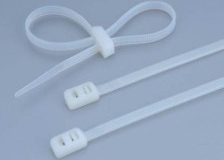
What Are the Available Types of Cable Ties?
There are several types of cable ties each with different features and functionalities. We can classify them into the following categories:
Belt Cable Ties
They are popularly used in the bundling of cables, especially electrical wires. Generally, belt cable ties have simple designs and they provide a convenient way of reducing clutter and enhancing cable security.
These types of cables are also available in different types. They have flexible designs in addition to quick-release techniques. At a glance, the main features of belt cable ties include:
* A quick and effective release mechanism* A flexible design
Generally, belt cable ties are cost-effective and the fact that they offer secure fitting makes them stand out. They are exceptionally strong and ideal for use in different types of industries.
Metal zip ties
They are ideal for use in challenging environments. Metal zip ties suit applications that have extreme levels of material requirements in harsh environmental conditions or if they need extreme tensile strength. Generally, these ties guarantee users high levels of fire resistance and maximum level of safety.
In industrial cases, metal zip ties are used in chemical processing plants since they have high-grade guards that can withstand corrosive damage. That’s why you will find such types of zip ties in the petrochemical industry, ships, mines, and tunnels.
Heavy-duty cable ties
Based on the industry standards, they are considered to be the strongest types of cable ties. Heavy-duty wires offer an incredibly high level of support and some of them can handle and support bundles weighing up to 250 lbs.
These cables gave high levels of reliability and durability and that’s why in most cases they are used in the construction industry.
They are ideal for indoor applications as well as outdoor applications since they offer a greater level of resistivity, particularly to UV light.
Heavy-duty cables are also thicker than your usual wires. This is to ensure that they effectively handle heavy tasks with a superb level of efficiency. The most notable characteristic of heavy-duty cable ties is that they are ideal for bundling heavy objects.
Heavy-duty strap and buckle
These cables come with a buckle that acts as the teeth for grip. So, you need to insert the webbing through the underside part of the buckle and then press the buckle in order to create the webbing space.
For a tighter grip, you need to pull the straps tighter so that the cables can withstand extra tension. These cables are improved versions of the standard heavy-duty types. They can, therefore, withstand more tensile strength.
Research shows that heavy-duty strap and buckle can support heavy-duty applications with a maximum tensile strength of up to 350 lbs.
besides that, the teeth located on the buckle grip are normally used to permanently grip the strap while the buckles are normally preassembled on the far ends of the straps.
Which Industries Use Cable Ties?
What are the Components of a Cable Tie?
How do You Maintain Cable Ties?
How Do You Determine the Effectiveness of Cable Ties?
How Can You Use Cable Ties at Home?
What are the Quality Standards for Cable Ties?
Are There Other Tools that You Need to Install Cable Ties?
What are the Advantages of Cable Ties?
Basic features of the standard cable ties
How Do You Choose the Right Type of Cable Ties?
What are the Common Specifications of Cable Ties?
What is the most common cable tie?
What are the strongest cable ties?

